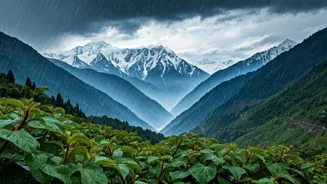Snowfall in Peaks
The higher reaches of Kashmir witnessed fresh snowfall, transforming the landscape. The snowfall provided a stark contrast to the rain that had been lashing
the plains. This precipitation played a vital role in maintaining the region's delicate ecological balance and supplying the vital water resources that the valley relies upon. It also provided a picturesque view and improved the air quality in these higher regions. The impact of the snow could be seen in the changing temperature, which created a much colder environment in those areas. The snowfall helped in the formation of new landscapes in the mountains and increased the beauty of Kashmir.
Rain on Plains
While the mountains were draped in white, the plains of Kashmir faced a different scenario with heavy rainfall. The rainfall was a significant departure from the drier conditions that some areas had recently experienced. The rainfall had implications for agriculture and daily life across the region. Farmers looked forward to the rainfall providing the necessary water for their crops. The rainfall also led to changes in temperature in these regions and a rise in humidity levels. The rainfall disrupted everyday activities and impacted transportation, making travel difficult for the residents. Residents had to deal with flooded roads and other issues during the downpour. The weather was a true example of the diverse climate Kashmir experiences.
Weather's Dual Effect
The contrast between snowfall in the high-altitude areas and rainfall in the plains painted a picture of the diverse weather conditions across Kashmir. This duality underscored the varied microclimates that exist within the region. The difference in temperatures and the types of precipitation across different altitudes and terrains were noticeable. The conditions highlighted how weather patterns could shift dramatically, even across relatively short distances. The weather event was a showcase of the natural processes at work. The events reminded the people of the unpredictable nature of weather and the constant need to adapt to the changing conditions. The differing conditions impacted the lives of the people.
Impact on Life
The recent weather event had a noticeable influence on the day-to-day lives of people across Kashmir. The snowfall brought a change in the lifestyle of the mountain people. Travel and transportation became difficult due to the snow-covered roads. Rainfalls, however, affected the plains by interrupting daily activities and impacting transport. The rainfall brought significant changes in the local economy, impacting agriculture. Farmers felt the effects of the weather on their crops. The availability of food and other necessities also changed due to transport issues. The overall effect of the weather was a change in the dynamics of daily life and the local economy, demonstrating the impact of weather on people's lives in the region. People experienced both difficulties and opportunities due to the unusual climatic conditions.
Seasonal Transition
This weather event was a reminder of the seasonal transition in Kashmir. The presence of snowfall and heavy rainfall indicated the shifting of climate and season. The changing climate influenced the types of activities that people engaged in. The need for warmth and protection changed as per the weather patterns. The weather event set the stage for further changes in the region. The weather events acted as a precursor of the environmental changes that were happening. The conditions also offered a stark reminder of the resilience and adaptability of the people in the face of environmental variability. This seasonal transition underscored the interconnectedness of the region's ecosystem and the importance of being prepared for the changing conditions of the environment.




